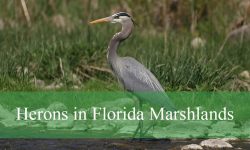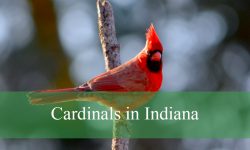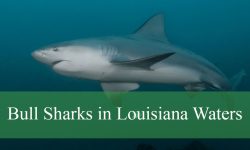You can find ducks anywhere in the world, even in Florida. Approximately 41 different species of ducks may be found in Florida; some of them are resident year-round, while others are migratory, depending on the time of year. Every duck in Florida shares the trait of always being close to a body of water.
Different Types of Ducks in Florida
Gadwall (Dabbling Duck)
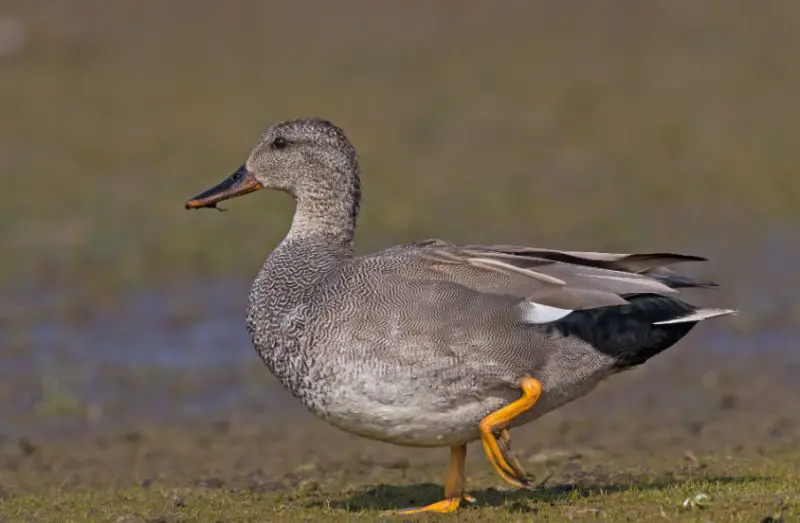
The Gadwall (Dabbling Duck) measures between 19 and 23 inches in length, weighing approximately 35.27 ounces, with a wingspan ranging from 31 to 36 inches. Found year-round in Florida, they frequent marshes, ponds, and lakes in summer, transitioning to reservoirs, ponds, and marshes in winter.
Male Gadwalls display delicate scalloped patterns, black tails, bills, and gray-brown heads, while females exhibit larger patterns in light and dark brown with orange bills. Both sexes feature white wing marks and primarily feed on aquatic plants and invertebrates.
Greater Scaup (Diving Duck)

The Greater Scaup (Diving Duck) measures between 15 and 22 inches in length, weighing from 1.5 to 2.9 pounds, with a wingspan spanning 28 to 33 inches. While not commonly found in most of Florida, they occasionally appear in the Panama City area during migration.
Males boast predominantly white bodies with black and brown barring on their backs and iridescent green heads during breeding season. Females exhibit dark brown heads, light brown bodies, and thick pale rings around the base of their bills.
Green-Winged Teal Duck (Dabbling Duck)
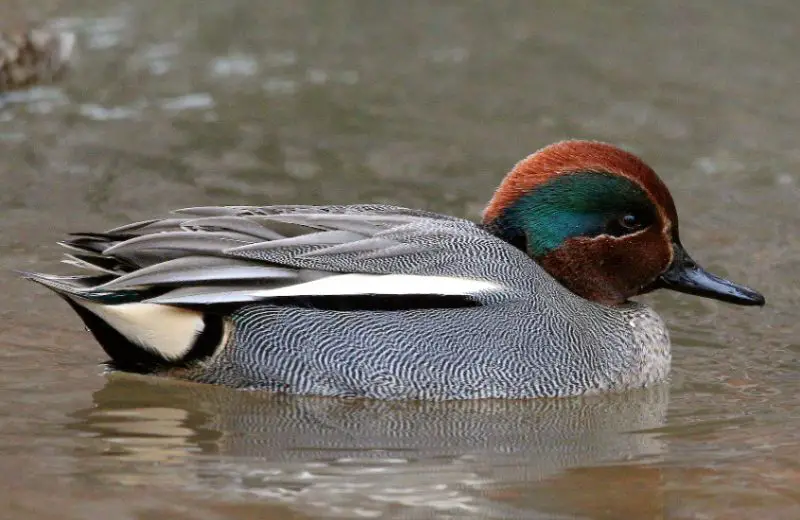
The diminutive Green-Winged Teal Duck (Anas crecca), ranging from 12.2 to 15.3 inches in length and weighing between 4.9 and 17.6 ounces, with a wingspan of 20.5 to 23.2 inches, winters throughout Florida.
They favor habitats like coastal estuaries, shallow lakes, inland ponds, and tidal marshes, often seeking areas with abundant floating vegetation.
Male Green-Winged Teal Ducks sport gray bodies, chocolate-brown heads, iridescent green eye stripes, and green speculum on their wings. Immature males and females resemble each other, displaying light and dark brown plumage, with females sporting a yellow streak on their tail feathers. Despite their small size, they can take off directly from the water.
Harlequin Duck (Sea Duck)
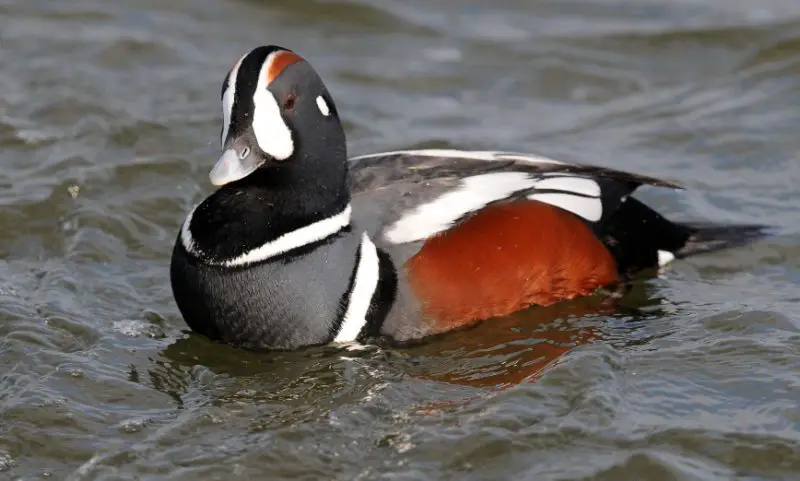
Although not common in Florida, occasionally, Harlequin Ducks (Histrionicus histrionicus) can be spotted in the state. Male Harlequin Ducks, with their slate blue bodies adorned with intricate patterns, feature black-outlined stripes on their necks, chests, and heads, complemented by chestnut brown accents. Females are less flamboyant, sporting dark brown plumage with a small white patch on their necks.
The Harlequin Duck typically measures between 15 and 21 inches (38 – 53 cm) in length, weighs about 24 ounces (680 g), and has a wingspan ranging from 26 to 28 inches (66 – 71 cm). Aptly nicknamed the “Sea Mouse,” these ducks emit mouse-like vocalizations, adding to their outstanding.
Hooded Merganser (Sea Duck)
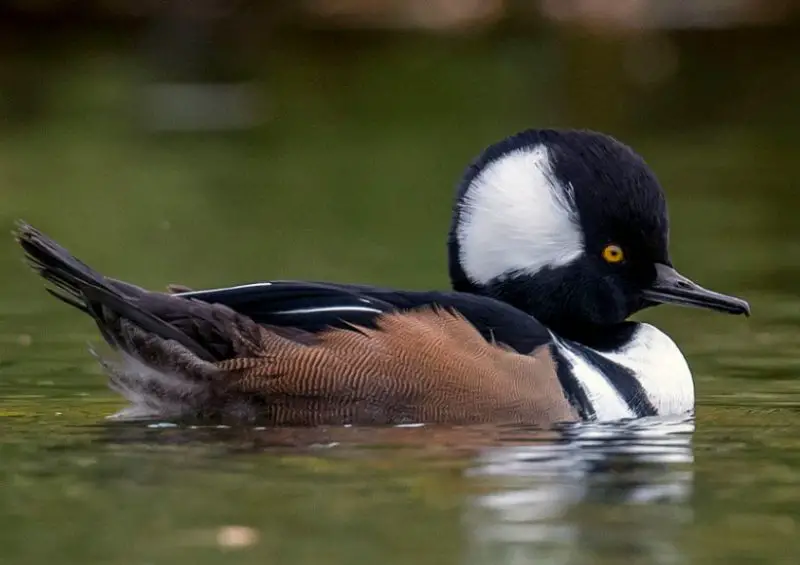
Hooded Mergansers, although rare breeders in Florida, are a common sight during the winter. It measures between 16 and 19 inches (41 – 48 cm) in length, weighs approximately 32.09 ounces (909 g), and boasts a wingspan of 24 to 26 inches (61 – 66 cm).
Males flaunt a striking black and white crest, which they can manipulate into a fan shape or a narrow stripe. Their bodies feature a mix of black, white, and brown, with a sleek black bill. Females sport a shaggy cinnamon-brown crest and lack distinctive markings, although some display hints of orange on their bills. Known as the “frog duck,” they emit a vocalization reminiscent of a pickerel frog.
King Eider (Sea Duck)
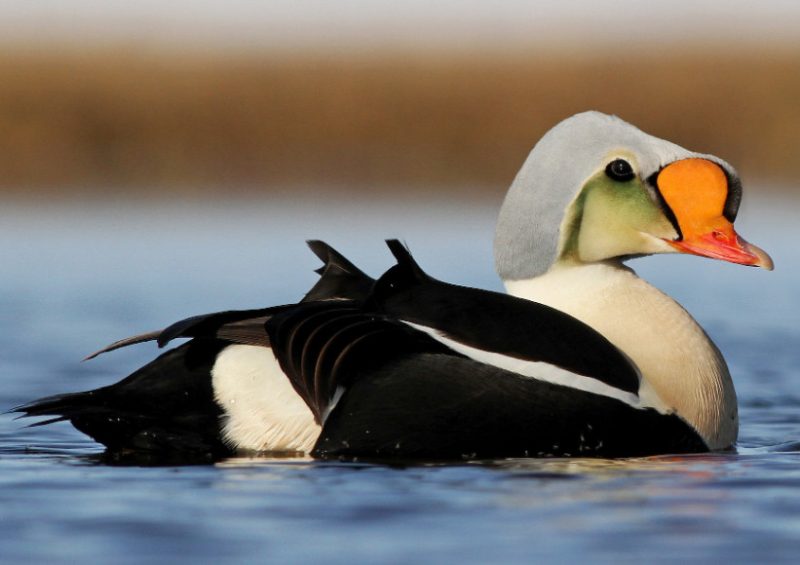
The King Eider, a sea duck, typically measures between 20 and 28 inches (50 – 70 cm) in length, weighs around 2.6 to 4.6 pounds (1.2–2.1 kg), and boasts a wingspan of 34 to 40 inches (86 – 102 cm).
While they typically winter along the Atlantic Coast of New England, some individuals have been observed migrating as far south as Florida.
Male King Eiders are distinguished by their oblong head, large orange plate above their bright red bill, and black and white body with a light blue crown. Female King Eiders, with their subdued dark brown appearance and black bill, lack the vibrant colors of the males.
Lesser Scaup (Diving Duck)
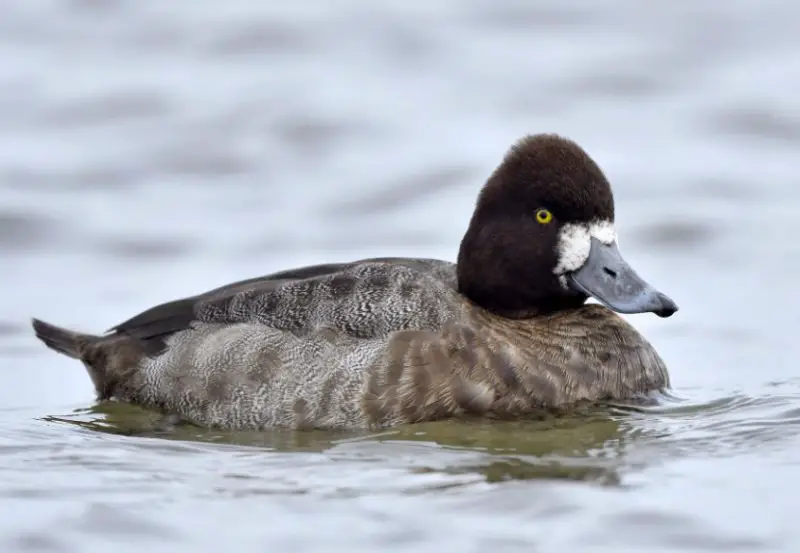
Lesser Scaup, a diving duck, measures between 15 and 18 inches (38 – 49 cm) in length, weighs approximately 40.77 ounces (1155 g), and possesses a wingspan of 24 to 33 inches (61 – 84 cm). These ducks migrate to Florida for the winter, often alongside Greater Scaup.
Male Lesser Scaup resemble their relatives with iridescent green and purple heads and gray and black barred bodies. Females are dark brown with a white face patch near their bills’ base. An easy way to differentiate Lesser from Greater Scaup is by the former’s tiny crest-like feathers on their heads. Lesser Scaup utilize camouflage and feigning death as their primary defense mechanisms.
Long-Tailed Duck (Sea Duck)
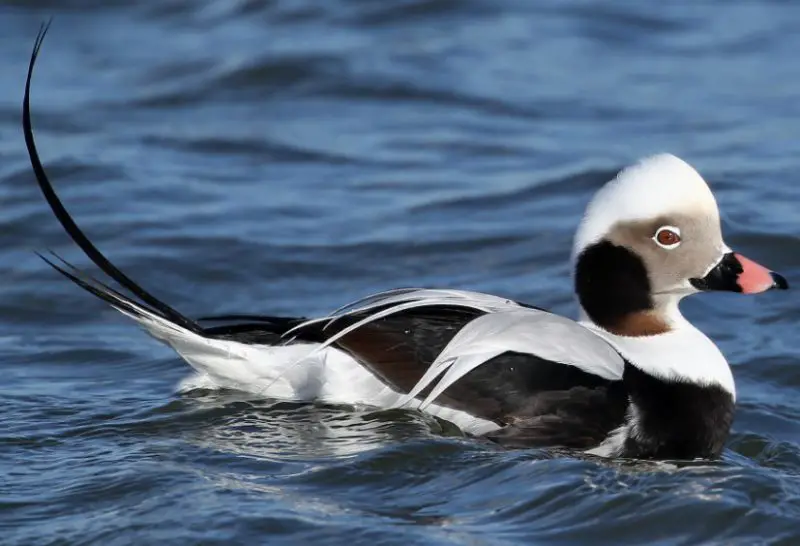
Long-Tailed Ducks, with lengths ranging from 15 to 22 inches (38 – 56 cm), and weighing around 31.74 ounces (900 g), have a wingspan of 26 to 31 inches (66 – 79 cm). While most remain in the Arctic after breeding, some migrate to Florida, staying offshore.
They exhibit remarkable color reversals between breeding and non-breeding seasons. Males and females undergo complete transformations, with black areas turning white and vice versa, making them unique among ducks.
Mallard Duck (Dabbling Duck)
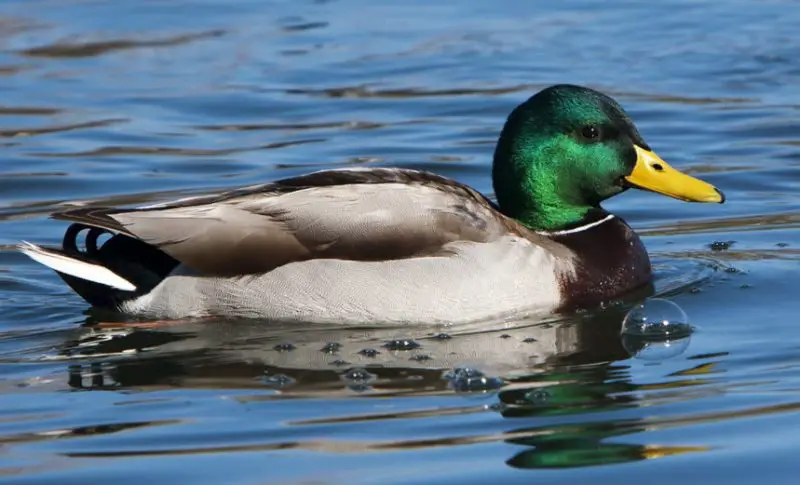
Mallard Ducks (Anas platyrhynchos), ranging from 19.7 to 25.6 inches (50 – 65 cm) in length and weighing between 35.3 and 45.9 ounces (1000 – 1300 g), have a wingspan of 32.3 to 37.4 inches (82 – 95 cm). As one of the most common ducks globally, they dominate North America and are abundant in Florida, particularly in the winter.
Mallards play a vital ecological role by dispersing seeds while foraging, contributing to wetland biodiversity. Their iconic appearance makes them easily recognizable and popular in various forms of art and decoration.
Masked Duck (Diving Duck)
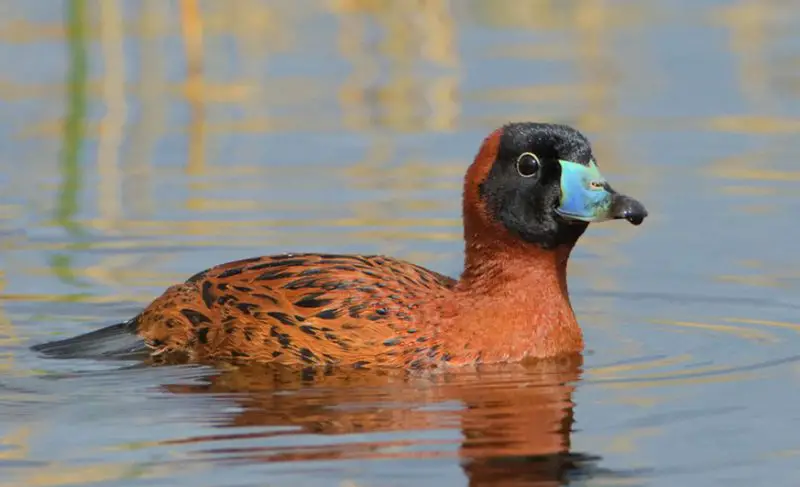
Masked Ducks (Nomonyx dominicus) are petite divers, measuring between 11.8 and 14.1 inches (30 – 36 cm) in length and weighing just 9.7 to 15.8 ounces (275 – 450 g), with a wingspan of 16.9 inches (43 cm). While typically found in tropical regions, occasional visitors reach Texas and Florida annually.
Males sport distinctive black face masks over their eyes, complementing their rusty-brown bodies and blue bills with black tips. Females feature cream-colored faces with two dark stripes, alongside dark brown plumage and black bills. As nocturnal feeders, they pose a challenge for researchers due to their elusive nature. Their diet comprises primarily aquatic plants and seeds, supplemented with crustaceans and aquatic insects.
Mottled Duck (Dabbling Duck)

The Mottled Duck (Anas fulvigula) is a distinctive dabbling duck, spanning 18.5 to 21 inches (47-53 cm) in length and weighing between 24.7 and 40.6 ounces.
With a wingspan ranging from 31.5 to 34.3 inches (80-87 cm), both males and females sport light and dark brown streaks and yellow bills, though females appear slightly less vibrant, with a hint of greenish on their bills.
They often interbreed with Mallard Ducks, posing a threat to their survival, especially with the release of pet Mallards in Florida and other Southeastern regions. Despite being primarily found in Florida, Louisiana, and Texas, they have also been introduced to South Carolina by duck hunters.
Muscovy Duck (Dabbling Duck)
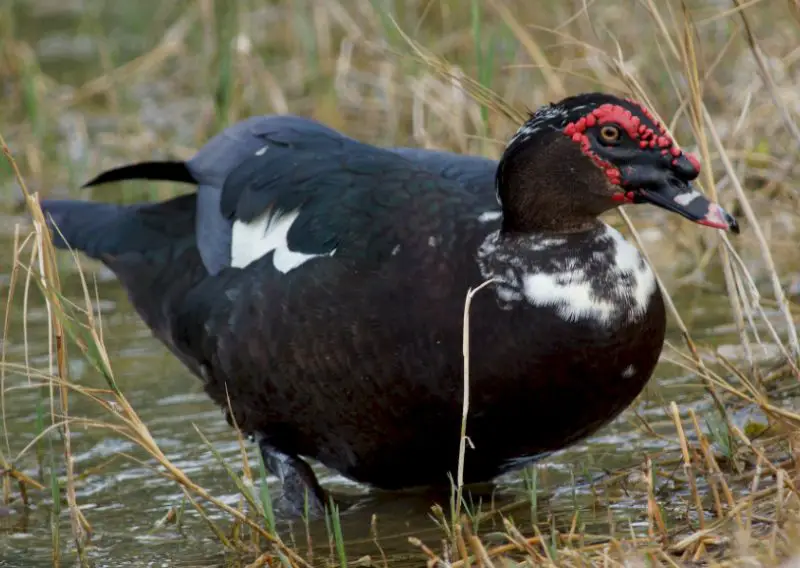
Muscovy Ducks (Cairina moschata) are sizable dabbling ducks, measuring between 26 to 33 inches (66-84 cm) in length and weighing from 2.4 to 9.0 pounds (1.1-4.1 kg).
With a wingspan ranging from 54 to 60 inches (137-152 cm), these ducks are considered invasive in Florida, where they outcompete native species and cause property damage.
While the males boast a mostly black plumage with white patches on their wings and red facial skin, females are smaller with a similar black-and-white appearance.
Northern Pintail (Dabbling Duck)
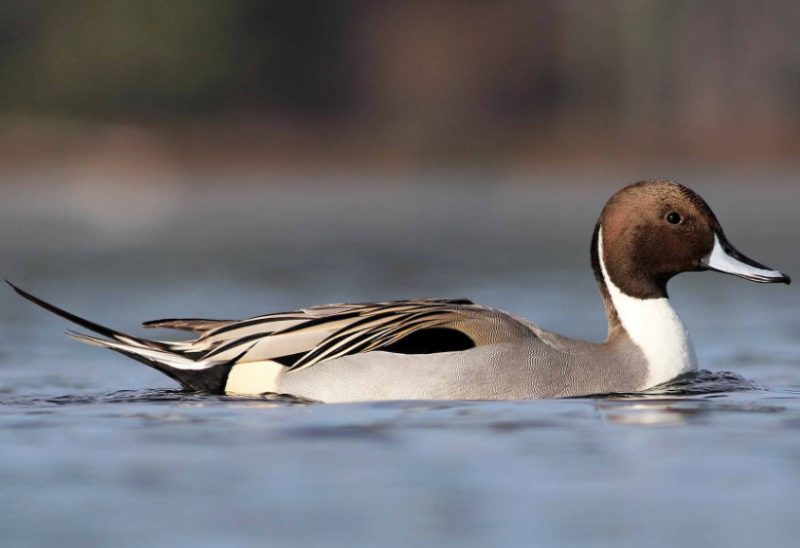
Northern Pintails (Anas acuta), measuring 20 to 26 inches (51-66 cm) in length and weighing 36.33 ounces (1030 g), winter in Florida, favoring shallow, muddy waters in both inland and coastal regions.
Male Pintails are distinguished by their long, pointed tail feathers, although these are typically lost before their arrival in Florida. Their bodies exhibit a mix of gray, white, black, and brown, with dark brown heads and a white neck stripe. Females possess shorter pointed tails and intricately patterned brown bodies.
Northern Shoveler (Dabbling Duck)
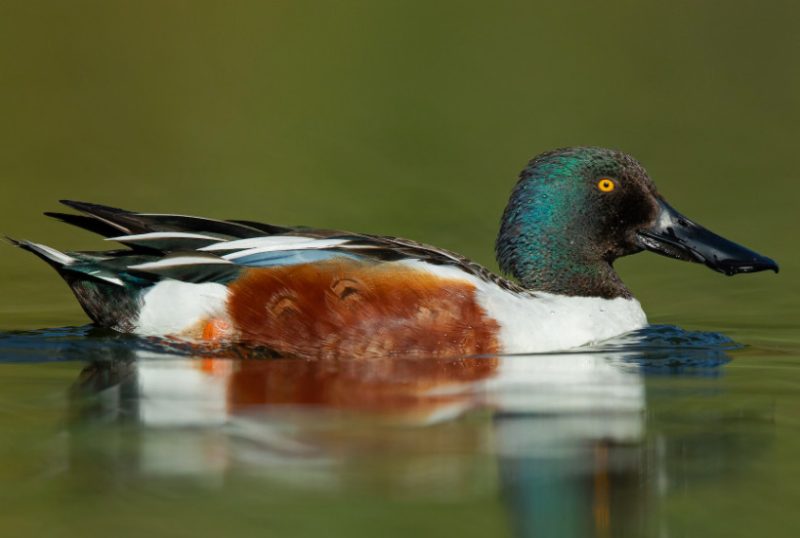
During the winter months, Northern Shovelers (Spatula clypeata) are commonly found in Florida, where they prefer freshwater and brackish marshes and ponds.
Measuring between 17.3 and 20.1 inches (44 to 51 cm) in length and weighing approximately 14.1 to 28.9 ounces (400 to 820 grams), with a wingspan ranging from 27.2 to 33.1 inches (69 to 84 cm), these ducks exhibit notable sexual dimorphism.
The males display an iridescent green head and a distinctive spatula-shaped black bill, while females have dark brown heads and bodies with various shades of brown. They employ a unique defense mechanism by defecating on their eggs to deter predators.
Red-Breasted Merganser (Sea Duck)
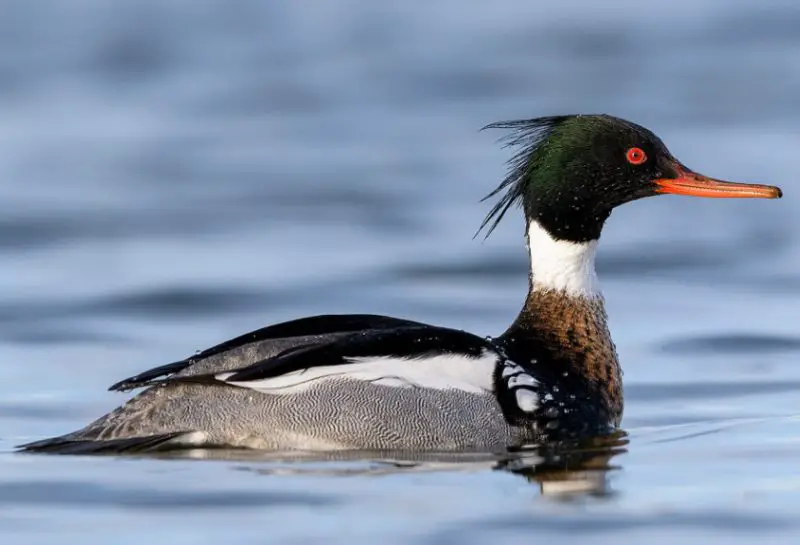
During the winter months, Red-Breasted Mergansers (Mergus serrator) can be spotted in Florida, primarily in the deep waters of the Atlantic Ocean and Gulf of Mexico. Rarely seen inland, these ducks are swift flyers, reaching speeds of up to 81 miles per hour.
Male Red-Breasted Mergansers sport shaggy crests, dark green heads, and distinctive white neck collars. Females exhibit cinnamon-brown heads with crests, complemented by gray-brown bodies and white throats. Their serrated bills are adept at tearing apart small fish, tadpoles, aquatic insects, and crustaceans.
The Red-Breasted Merganser (Mergus serrator) measures between 16 and 26 inches (41 to 66 cm) in length, weighs approximately 47.61 ounces (1349 g), and has a wingspan ranging from 31 to 35 inches (79 to 89 cm).
Redhead Duck (Diving Duck)

In winter, Florida teems with Redhead Ducks (Aythya americana), especially near Tampa Bay and Charlotte Harbor rivers. Preferring deep waters, they avoid forests and are vulnerable to brood parasitism, particularly near Canvasbacks.
Males boast dark reddish-brown heads, black chests, and gray backs, with dark gray bills tipped in black. Females, resembling males in bill coloration, are unremarkable in brown.
With lengths of 18-22 inches (46-56 cm), weights averaging 43.03 ounces (1219 g), and wingspans ranging from 29 to 35 inches (74-89 cm), Redheads are unmistakable diving ducks.
Ring-Necked Duck (Diving Duck)
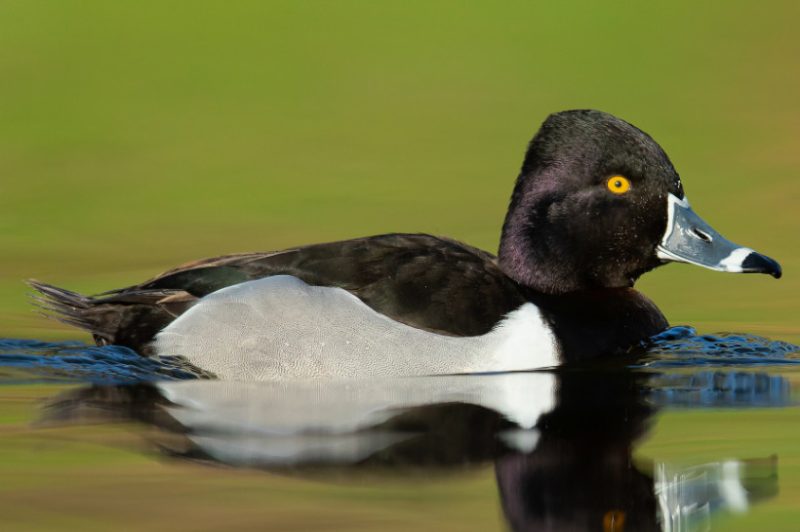
The Ring-Necked Duck, a common winter resident in Florida, frequents small lakes, ponds, and flooded lands. Despite its name, the copper ring around its neck is hardly visible. Instead, it sports a prominent white ring at the base of its bill.
Males are mostly black with gray sides, while females are brown and lack the white outline around the bill base. Their lengths range from 14 to 18 inches (36-46 cm), with weights averaging 32.09 ounces (909 g), and wingspans spanning 24 to 30 inches (61-76 cm).
Ruddy Duck (Diving Duck)

Ruddy Ducks are common winter residents in Florida, favoring protected estuaries and coastal marshes. During the breeding season, sightings of these ducks in the state are exceedingly rare.
Male Ruddy Ducks boast dark coloring in summer, including a black head and brown body with a prominent white cheek patch. Their coloration fades to a dull gray by winter. Females are dappled brown with a gray cheek patch and a black bill.
They measure 14-16 inches (35.56-40.64 cm) in length, weigh 28.04 ounces (795 g), and have a wingspan of 21-24 inches (53-61 cm).
Surf Scoter (Sea Duck)
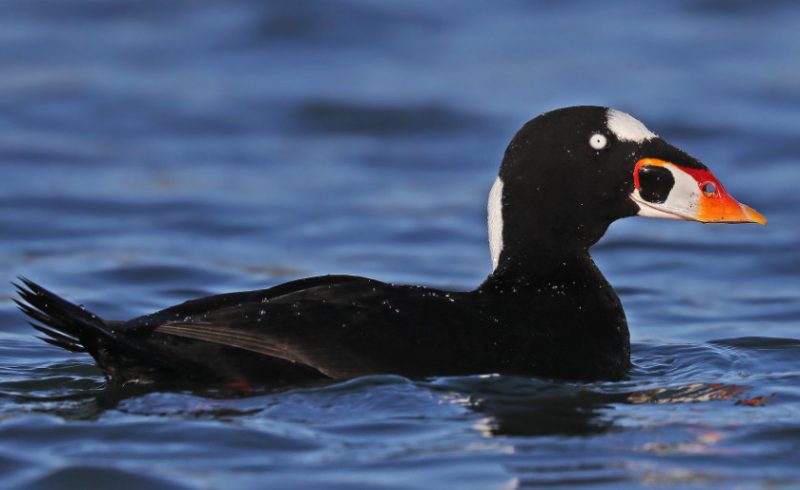
Surf Scoters, distinguished by their unique characteristics, are commonly found in specific areas along Florida’s northern coasts and the open waters surrounding the peninsula.
Males exhibit predominantly black plumage with sloping foreheads and a vibrant bill showcasing hues of orange, red, yellow, black, and white. Notably, they feature two prominent white patches—one above the bill and another at the base of the neck. In contrast, females are smaller, adorned in dark gray plumage with white patches on the neck and behind each eye, accompanied by a dark gray bill.
With a length ranging from 17 to 21 inches (43 to 53 cm), a weight of 35.27 ounces (1000 g), and a wingspan spanning 30 to 36 inches (76 to 91 cm), Surf Scoters are striking seabirds thriving in Florida’s coastal waters.
White-Cheeked Pintail (Dabbling Duck)
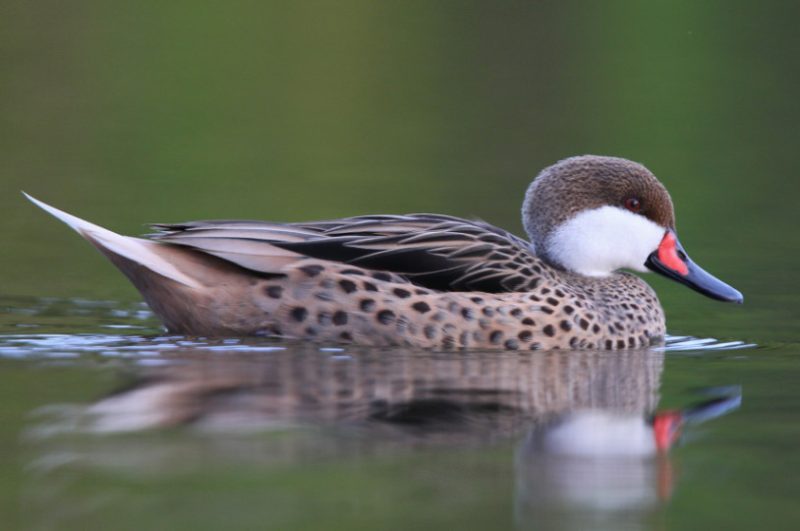
White-Cheeked Pintails, year-round Caribbean residents, occasionally wander into Florida as accidental visitors. They sport long, pointy tails, a characteristic defining pintails, complemented by bright white cheeks.
The White-Cheeked Pintail (Anas bahamensis) measures between 22.8 and 25.5 inches (58 to 65 cm) in length, weighs approximately 17.7 to 20.7 ounces (503 to 569 g), and boasts a wingspan ranging from 23.6 to 26.7 inches (60 to 68 cm).
Resembling female Northern Pintails, both genders feature bills with a mix of black and orange hues. Despite their similarity in appearance, these ducks inhabit a variety of freshwater and saltwater habitats, adding to the diversity of Florida’s avian population.
White-Winged Scoter (Sea Duck)
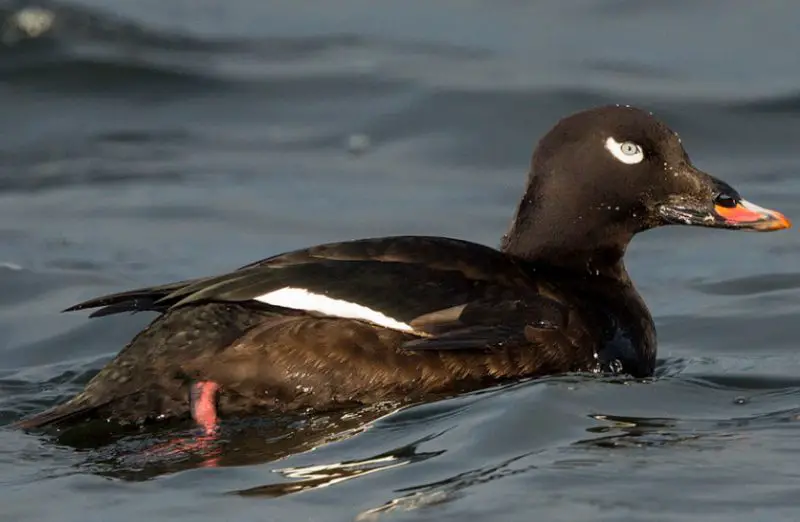
White-Winged Scoters are rare sights in most of Florida, but some can be spotted near Pensacola and Jacksonville during winter.
The White-Winged Scoter measures between 19 to 24 inches (48 to 61 cm) in length, weighs about 62.4 ounces (1768 grams), and boasts a wingspan spanning 33 to 41 inches (84 to 104 cm).
Male and female White-Winged Scoters share similar appearances with dark bodies and thick bills. However, males are slightly darker and sport a white comma shape over their eyes, while females have small white patches on each cheek. A notable distinction is the color of their bills, with females having entirely black bills and males featuring red bills from the halfway point forward.
Wood Duck (Dabbling Duck)
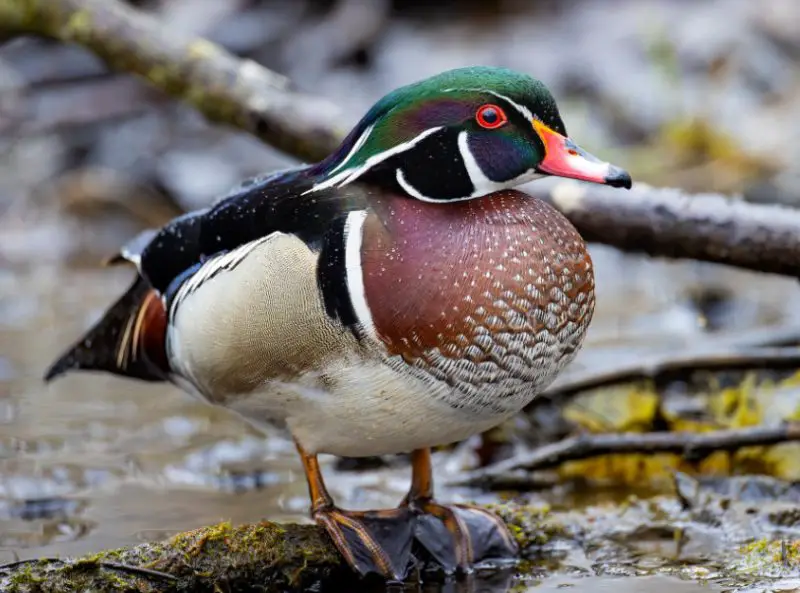
Wood Ducks, year-round residents in Florida, increase in numbers during winter. They nest in tree cavities near wetlands during summer, favoring vegetated areas in winter.
Males flaunt vibrant plumage with chestnut breasts, green heads, and long crests. They bear white stripes and multi-colored bills. Females, with smaller crests, sport gray heads, brown bodies, and white-outlined eyes.
Wood Ducks measure 18.5 to 21.3 inches (47 to 54 cm) in length, weigh 16.0 to 30.4 ounces (454 to 862 g), and have a wingspan of 26.0 to 28.7 inches (66 to 73 cm).
American Black Duck (Dabbling Duck)

The American Black Duck (Anas rubripes) is an exclusive species inhabiting the eastern half of North America. Ranging from 21.3 to 23.2 inches in length and weighing 25.4 to 57.9 ounces, these ducks flaunt a wingspan of 34.6 to 37.4 inches.
The male American Black Duck stands out with its dark brown body and bright blue speculum on the wings, visible during flight. Resembling female Mallards, their distinguishing feature is the yellow bill, while female Mallards have an orangeish-gray bill. Females sport a lighter brown plumage with a green bill. These ducks prefer wooded habitats like marshes, rivers, and ponds, with deforestation posing a threat to their survival.
American Wigeon (Dabbling Duck)

The American Wigeon (Mareca americana), a dabbling duck, stands out with its distinctive features. Measuring up to 14 inches in length and weighing about 2.25 pounds, with a wingspan of 34 inches, these ducks are prevalent winter visitors in Florida and various regions across North America.
The male American Wigeon, nicknamed “baldpate,” boasts a striking appearance, characterized by a bright white crown, contrasting brown head and body, iridescent green patch over the eyes, black-tipped wings, and a bluish-gray bill.
Black-Bellied Whistling Duck (Tree Duck/Dabbling Duck)
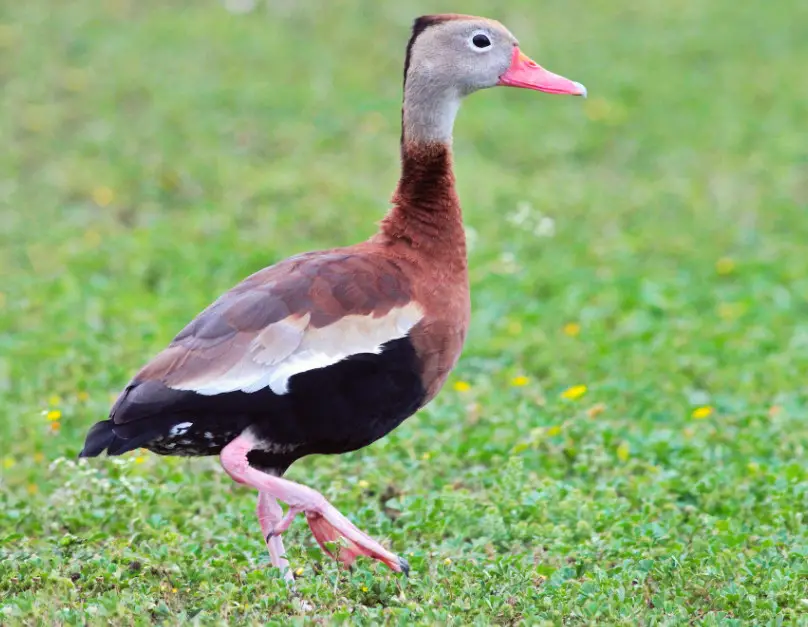
The Black-Bellied Whistling Duck (Dendrocygna autumnalis), also known as the Tree Duck or Dabbling Duck, is a distinctive species with identifiable characteristics. Measuring between 19 and 22 inches in length, with a weight ranging from 652 to 1020 grams and a wingspan of 30 to 37 inches, these ducks have been a regular presence in Florida since 1968, primarily inhabiting the peninsula.
They are known for their whistling calls while flying, swimming, or standing. Sexually monomorphic, both male and female Black-Bellied Whistling Ducks feature a dark brown crest, brown breast, gray face, pink bills, and black bellies. They utilize debris piles or tree cavities for nesting instead of constructing their own.
Black Scoter (Diving Duck)
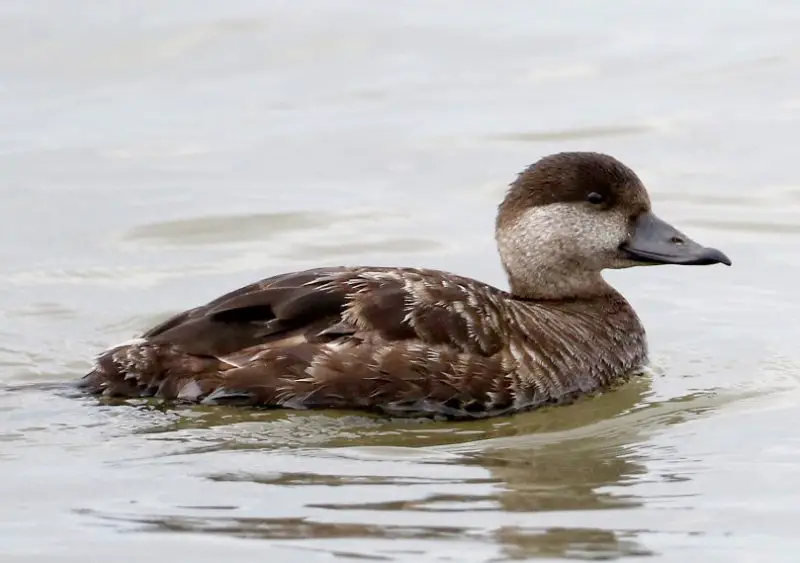
The Black Scoter (Melanitta americana), a diving duck, showcases distinct features for identification. Ranging from 17 to 21 inches in length, weighing approximately 1088 grams, with a wingspan of 30 to 35 inches, these ducks predominantly winter along the Atlantic and Gulf Coasts of the Eastern US.
Males are distinguished by their black plumage and orange bulge at the base of the bill, while females exhibit mottled light brown feathers, dark brown crowns, gray cheeks, and black bills.
Blue-Winged Teal Duck (Dabbling Duck)
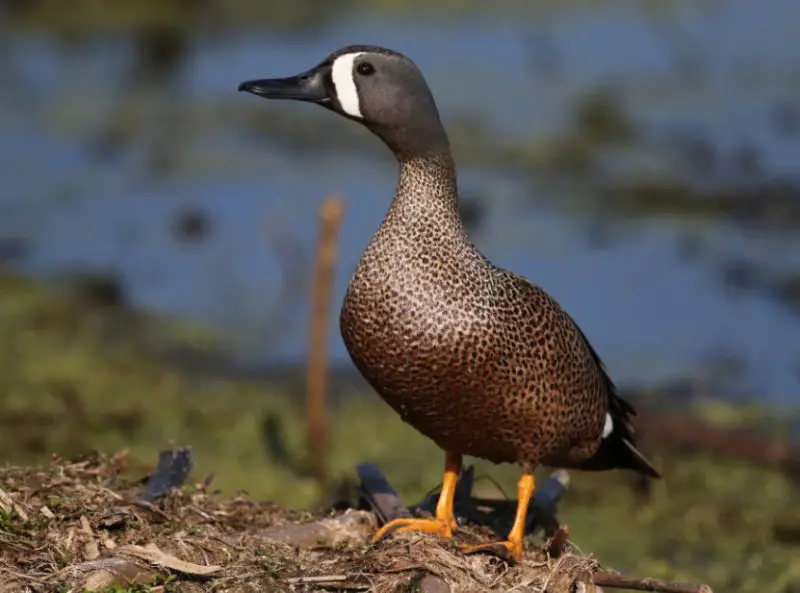
The Blue-Winged Teal Duck (Spatula discors) is a dabbling duck with unique identifying features. Typically measuring 15 to 17 inches in length, weighing around 19.18 ounces, with a wingspan of 23 to 31 inches, they are rare nesting residents of Florida, often seen in winter in grassy ponds and calm marshes.
Male Blue-Winged Teal Ducks have gray heads, mottled brown bodies, white crescent-shaped patches in front of their eyes, green speculum, and blue shoulder patches. Females lack distinct facial markings and have brown bodies with speckles. They primarily feed on seeds. Despite their small size, Blue-Winged Teal Ducks face high mortality rates due to their extensive migratory journey between Canada and South America twice a year.
Bufflehead (Diving Duck)
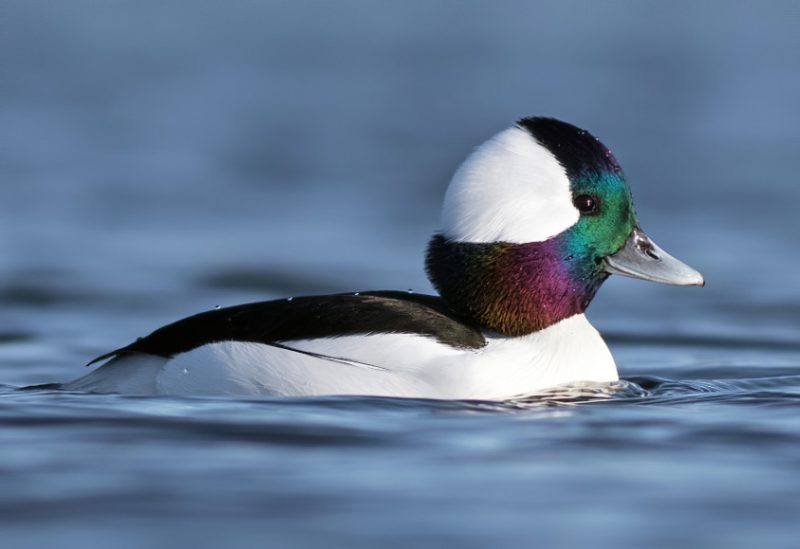
The Bufflehead (Bucephala albeola), a diving duck, displays distinctive characteristics for identification. Measuring between 13 and 16 inches in length, weighing approximately 21.16 ounces, with a wingspan of 22 inches, these ducks winter in northern Florida, inhabiting inland ponds and protected coastal coves.
Both male and female Buffleheads have large, fluffy heads; males feature a striking color-block pattern of white, iridescent green, and purple, while females sport dark gray heads with white patches on each cheek. Buffleheads are cavity-dwellers and can easily adapt to nesting boxes. When observed on land, their small, far-set legs may make them appear a bit clumsy.
Canvasback (Diving Duck)
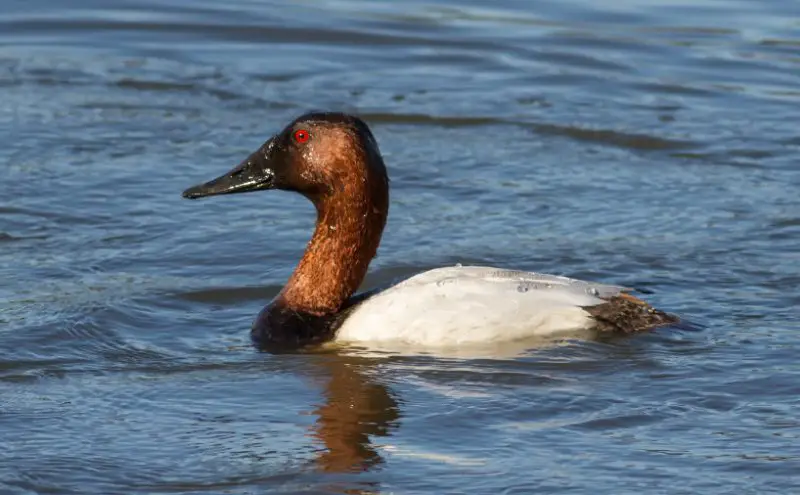
The Canvasback (Aythya valisineria), a diving duck, displays distinctive features for identification. Typically measuring between 19 and 24 inches in length, weighing around 58.48 ounces, with a wingspan of 28 to 36 inches, these ducks are regular winter residents of Florida, often found in ponds and marshes such as Apopka Lake and Viera Wetlands.
The male Canvasback boasts a reddish-brown head with a large, sloping forehead, canvas-gray body, thick black bill, red eyes, and a black tail. Females exhibit similar patterning but in muted colors with red eyes. Their diet primarily consists of wild celery, a native plant in Florida. Tracking the presence of wild celery can lead to spotting Canvasbacks.
Cinnamon Teal Duck (Dabbling Duck)

Cinnamon Teal Ducks (Spatula cyanoptera), though rare visitors to Florida, are occasionally spotted in the state during winter, including Merritt Island. Males exhibit vibrant colors during breeding season with a dark rusty-brown head, black primary feathers, and green secondary feathers, while winter males display faded coloring resembling females. Females are coarsely mottled in dark and light brown, sporting a thick black bill. Both genders measure around 11 inches in length, weighing between 12.6 and 18.2 ounces, with a wingspan of 25 inches.
Common Eider (Sea Duck)
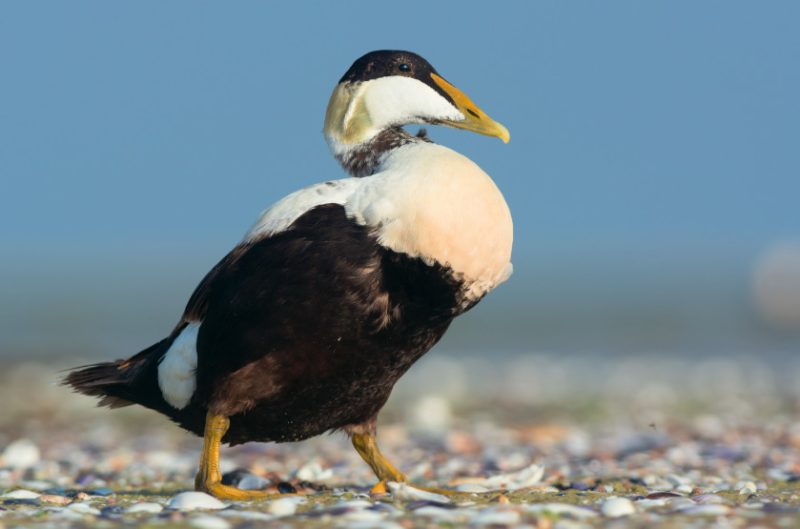
The Common Eider (Somateria mollissima), a sea duck, is a rare winter visitor in Florida, primarily breeding along the Arctic Ocean and Hudson Bay. During non-breeding seasons, they migrate down the Atlantic Coast, occasionally reaching Florida.
Male Common Eiders are large, featuring black and white plumage with light green neck coloring, and their bill color varies. Immature males and females are brown, with males displaying white patches. Females exhibit dark brown and black barring on their bodies.
Common Goldeneye (Sea Duck)
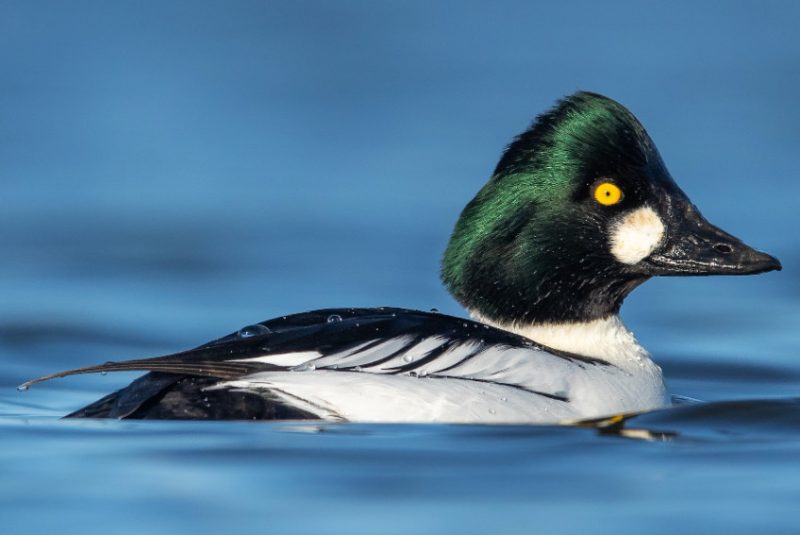
The Common Goldeneye (Bucephala clangula), a sea duck, is a winter visitor across most of the US after breeding in Canada, excluding the US southeast and inland Florida. Measuring 16-20 inches in length and weighing approximately 1.8 pounds, with a wingspan of 30.3-32.7 inches.
Males feature iridescent green heads, black and white bodies, yellow eyes, and white wing patches. Females exhibit brown bodies, black bills with yellow tips, and yellow-gold eyes. Their aggressive behavior occasionally leads to the formation of accidental creches, where ducklings from different nests are raised together.
Common Merganser (Sea Duck)
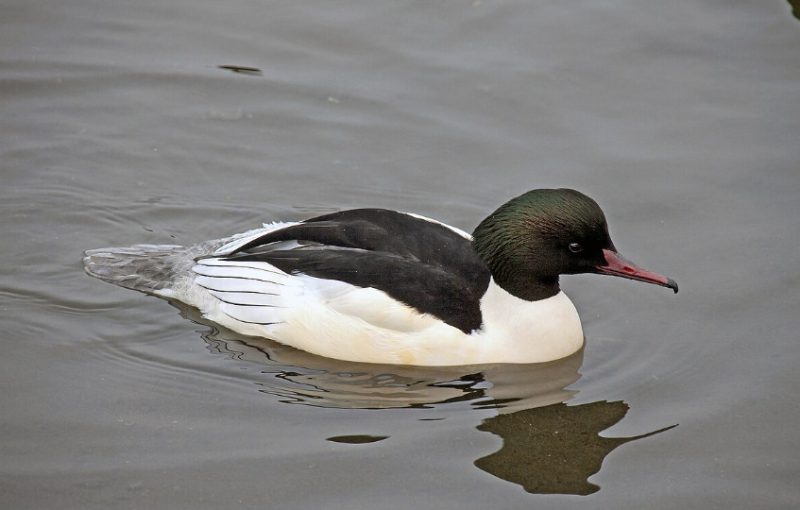
The Common Merganser (Mergus merganser), a sea duck, is a winter resident along the Atlantic Coast, spanning from Newfoundland to the northern edge of Florida. It measures 22 to 27 inches (56 to 69 cm) in length, weighs 60.8 ounces (1723 g), and has a wingspan of 31 to 37 inches (79 to 94 cm).
Males feature an iridescent green head, white belly, black eyes and back, and a long, bright red bill, while females sport a reddish-brown head with a shaggy crest and gray back and belly. Their serrated bills are specialized for consuming fish, frogs, worms, and mollusks, aligning with their habitat preferences often seen alongside Buffleheads.
Eurasian Wigeon (Dabbling Duck)
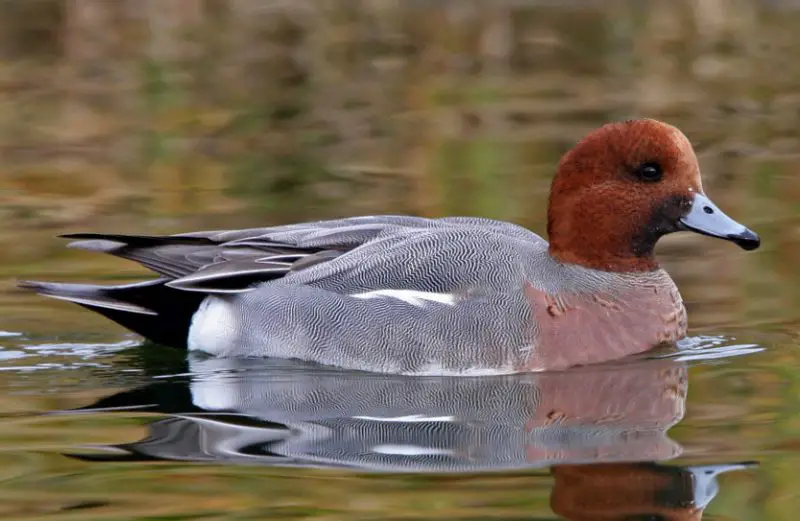
The Eurasian Wigeon (Mareca penelope), a dabbling duck, is a rare visitor to North America, typically found across Russia, Europe, and China. They occasionally migrate to the United States for winter, with Florida being one of the few states they visit.
Males feature a rufous head with a beige forehead, light brown chest, gray body, and a gray bill with a black tip. Females exhibit dark brown plumage with a light-colored belly and dark markings on their backs, along with a bill resembling that of males.
Fulvous Whistling-Duck (Tree Duck/Dabbling Duck)
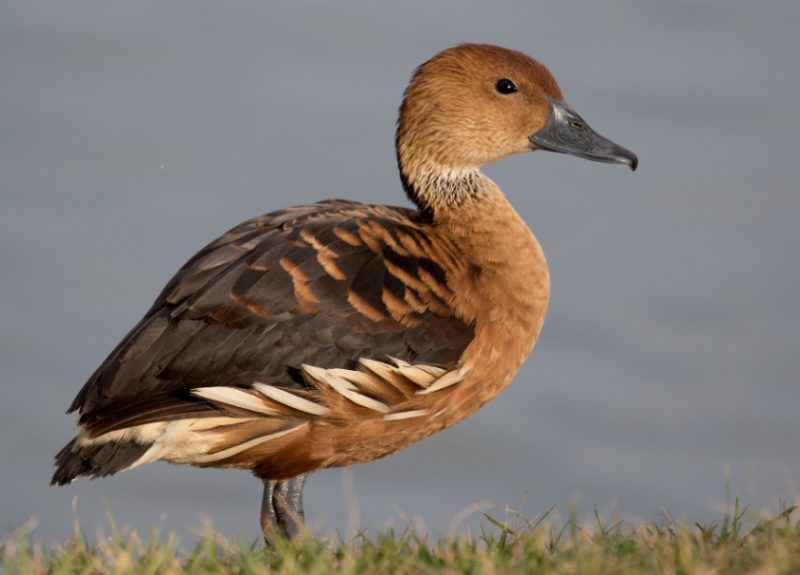
The Fulvous Whistling-Duck (Dendrocygna bicolor), a tree duck or dabbling duck, measures between 18 and 21 inches in length, weighs 25 to 37 ounces, and boasts a wingspan of 33 to 40 inches. Common breeding residents of Florida for around 30 years, they inhabit freshwater wetlands across the state.
Sexually monomorphic, both males and females feature caramel-brown bodies with black stripes on their backs, along with long necks and legs. They are proficient filter feeders, utilizing their bills to strain water and extract food.

